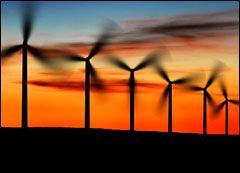Last year, California suffered the ultimate indignity in its quest to be the “greenest state.” It was passed by red Texas — the oil heartland — for the title of state with the most wind-power generating capacity.
The numbers get even more depressing. Last year, California’s wind capacity grew at a slower rate than any of the other top 10 wind-producing states. Texas’s wind production grew at a 39 percent clip and (What’s the Matter With) Kansas’ grew by 38 percent; California managed relatively meager 10 percent growth. That still leaves the Golden State as the No. 2 wind producer in the country, but it is clearly in a slump.

Has the sun set on California’s wind-power dominance?
Photo: iStockphoto
Why has California blown its lead (so to speak)? The state was an early champion of wind farms. During the 1980s, when Texans thought only of oil and gas drilling, California started putting in windmills. By 1985, turbines had sprouted in three key areas: Altamont, east of San Francisco; Tehachapi, near Bakersfield; and San Gorgonio, in the far south. The energy crisis of the 1970s, plus regulatory initiatives in California, had galvanized action.
Ironically, California’s early pioneering is part of its trouble. Regulations, well-developed through the years, make it hard for developments to get off the ground. Hal Romanowitz of Oak Creek Energy Systems, a Mojave-based wind developer focused on Tehachapi, describes California as “probably the most difficult state in the country to build in.” Nancy Rader of the California Wind Energy Association notes that land is quite expensive in California — and that while Texas provides property-tax exemptions to people with windmills on their land, California does not.
A big barrier is birds. Whereas Texan officials publicly scoff at avian travails, California developers have been cowed by lawsuits over bird deaths. The technology of 20 years ago — using small blades that rotated very quickly — did indeed spell the end for many birds. This January, Alameda County settled a lawsuit with Golden Gate Audubon Society and others concerning bird deaths at Altamont Pass. The wind industry is supposed to cut the number of raptor deaths there in half by the end of 2009. (Golden Gate says that up to 4,700 birds die each year in the Altamont windmills.) Development at Altamont remains basically frozen because of bird issues, though a few hundred megawatts have gone up in nearby Solano County, near the Sacramento River delta — including several 3-MW turbines that are the largest wind structures in the country.
The wind industry says that technology has improved: turbines nowadays have longer blades, which rotate more slowly than the old types while generating more energy. That is supposedly good news for birds. Also, the California Energy Commission is soon to come out with new (voluntary) guidelines for reducing impacts on birds and bats from wind turbines, which may help clarify matters for wind developers.
But as if birds were not enough, there is the military. Turbines are commonly a few hundred feet high, not only making them a potential hazard for pilots in low-fly zones, but raising concerns about radar interference. Travis Air Force Base in Solano County recently held up a wind project at the last minute over radar issues. In Kern County, which includes Tehachapi, parts of the area were “out of play” for a few years, says Rader, because the military effectively barred anything above 200 feet. And in San Bernardino, there is “a huge amount of good wind land that is just not going to be useable because of military considerations,” says Romanowitz.
But the real bottleneck may be lack of transmission capacity — in particular in Tehachapi, home to the largest undeveloped, onshore wind resource in the state. “Basically since 1986 there has been no additional transmission capacity” in Tehachapi, with the exception of a private transmission line built some 15 years ago, says Romanowitz.
The good news is that California may be poised for a comeback. The state is certainly at the forefront of pushing renewable energy; 20 percent of California’s retail electricity is supposed to come from renewables by 2010.
Transmission shortages will soon ease, wind advocates hope. “California is now on a roll to do significant new transmission, significant new generation,” says Romanowitz. His company is committed to the Tehachapi region, where a project to build more than 4,000 MW of additional transmission capacity is in the works. In theory, it should start coming online in stages, starting next year. But the approval process — notoriously protracted in California — is still under way. Nonetheless, Rader says that 15,000 MW of new wind projects are currently planned in California — more than six times the current capacity. She believes that wind could supply 20 percent of California’s energy needs by 2020 — up from less than 2 percent today.
That sounds like the stuff of dreams. A more realistic goal may be catching Texas, whose cowboy wind developers may stumble over transmission problems themselves.

